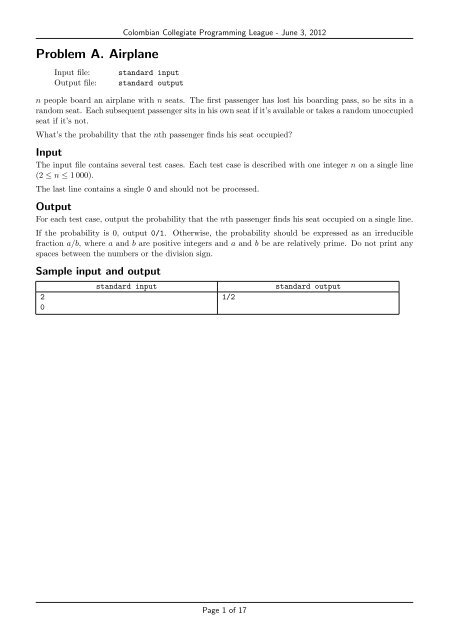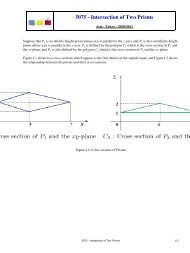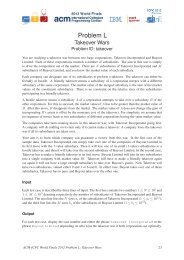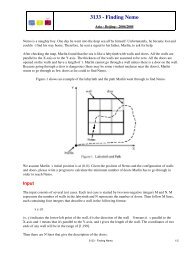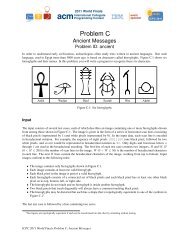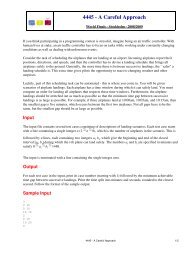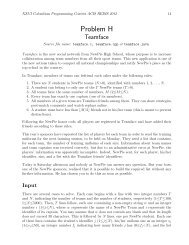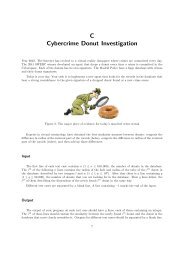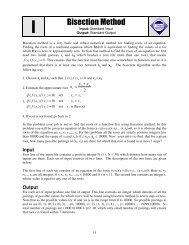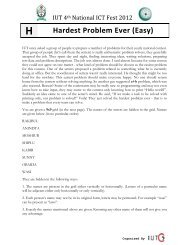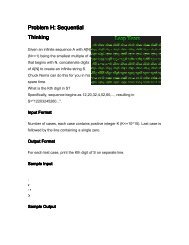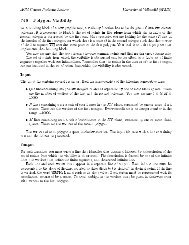problems in PDF - UVa Online Judge
problems in PDF - UVa Online Judge
problems in PDF - UVa Online Judge
You also want an ePaper? Increase the reach of your titles
YUMPU automatically turns print PDFs into web optimized ePapers that Google loves.
Colombian Collegiate Programm<strong>in</strong>g League - June 3, 20122 3 1 7 3 5 2 3 1 7 3 5 2 3 1 7 3 5The area of the nice rectangle <strong>in</strong> the leftmost figure is 6×1 = 6 square units, the area of the nice rectangle<strong>in</strong> the middle figure is 3 × 3 = 9 square units and the area of the nice rectangle <strong>in</strong> the rightmost figure is1.8 × 2.6 = 4.68 square units.Clearly, the area of the rectangle <strong>in</strong> the middle figure is largest. In fact, it turns out it doesn’t exist anice rectangle for this histogram with a larger area!In this problem, you are given a histogram and your task is to compute the maximum area of all thepossible nice rectangles. By the way, it is not hard to prove that this area will always be an <strong>in</strong>teger.InputThe <strong>in</strong>put conta<strong>in</strong>s several test cases (at most 50).Each test case is described by several l<strong>in</strong>es. The first l<strong>in</strong>e conta<strong>in</strong>s two <strong>in</strong>teger N and C, the number of barsand the total number of colors <strong>in</strong> the histogram, respectively (1 ≤ N ≤ 10 5 and 1 ≤ C ≤ m<strong>in</strong>(30, N )).The follow<strong>in</strong>g l<strong>in</strong>e conta<strong>in</strong>s N <strong>in</strong>tegers h i , the height of the ith bar from left to right (1 ≤ h i ≤ 10 9 ). Thefollow<strong>in</strong>g l<strong>in</strong>e conta<strong>in</strong>s N <strong>in</strong>tegers c i , the color of the ith bar from left to right. Each color is representedas an <strong>in</strong>teger between 0 and C − 1, <strong>in</strong>clusive. You can assume that for each histogram there will be atleast one bar of every color.The last l<strong>in</strong>e of the <strong>in</strong>put conta<strong>in</strong>s two zeros and should not be processed.OutputFor each test case, output a s<strong>in</strong>gle <strong>in</strong>teger on a s<strong>in</strong>gle l<strong>in</strong>e — the area of the largest nice rectangle for thishistogram.Page 3 of 17
Colombian Collegiate Programm<strong>in</strong>g League - June 3, 2012Sample <strong>in</strong>put and outputstandard <strong>in</strong>put6 32 3 1 7 3 52 0 1 0 1 23 12 2 20 0 05 23 2 1 2 31 0 1 0 16 41 2 3 4 5 60 1 2 3 1 07 21 2 3 4 3 2 10 1 0 1 0 1 010 22 1 2 1 1 2 1 2 2 11 0 0 0 1 0 0 1 1 03 21000000000 999999997 9999999990 1 10 09651210102999999991standard outputExplanation of the sample casesBelow are some of the sample test cases with their respective largest nice rectangles:2 2 2Example 23 2 1 2 3Example 31 2 3 4 5 6Example 41 2 3 4 3 2 1Example 52 1 2 1 1 2 1 2 2 1Example 6Page 4 of 17
Problem C. Little NephewColombian Collegiate Programm<strong>in</strong>g League - June 3, 2012Input file:Output file:standard <strong>in</strong>putstandard outputYour little nephew is 5 years old. He tells you he has a hats of different colors, b T-shirts of differentcolors, c pants of different colors, d pairs of socks of different colors and e pairs of shoes of different colors(you know how kids are). He is on that age where kids ask and ask questions all day long. He asked you<strong>in</strong> how many different ways he could possibly get dressed.S<strong>in</strong>ce he is just 5, sometimes he wears socks or shoes of different colors. For example, he might wear ared sock on his right foot and a blue sock on his left foot. We will consider two ways of dress<strong>in</strong>g differentif they differ <strong>in</strong> the color of the hat, the color of the T-shirt, the color of the pants, the color of the sockon the left foot, the color of the sock on the right foot, the color of the shoe on the left foot or the colorof the shoe on the right foot.He’s clever enough to figure out which is the left shoe and which is the right shoe, so he’ll never put thewrong shoe on the wrong foot like you used to do. Also, he always wears a hat, a T-shirt, a pair ofpants, a pair of socks and a pair of shoes (I guess someone told him it’s not good to go walk<strong>in</strong>g aroundthere half-naked).Here’s an example. If he has one red hat, two T-shirts (one blue and one green), one pair of pants (black),two pairs of socks (one white pair and one orange pair) and two pairs of shoes (one brown pair and theother one yellow) then he can dress <strong>in</strong> 32 different ways. Here are some of the valid different ways howhe can dress (the changes between consecutive ways <strong>in</strong> this list are shown <strong>in</strong> bold):• The red hat, the blue T-shirt, the black pants, a white sock on the left foot, a white sock on theright foot, a brown shoe on the left foot, a brown shoe on the right foot.• The red hat, the green T-shirt, the black pants, a white sock on the left foot, an orange sock onthe right foot, a brown shoe on the left foot, a brown shoe on the right foot.• The red hat, the green T-shirt, the black pants, an orange sock on the left foot, a white sock onthe right foot, a brown shoe on the left foot, a brown shoe on the right foot.• The red hat, the green T-shirt, the black pants, an orange sock on the left foot, a white sock onthe right foot, a brown shoe on the left foot, a white shoe on the right foot.Notice that the only difference between the second and the third way is that he swapped the color of hisleft and right socks. These are two different ways of gett<strong>in</strong>g dressed accord<strong>in</strong>g to the rules above.He said that if you wrote a program that could calculate this number he would stop ask<strong>in</strong>g questions!InputThe <strong>in</strong>put conta<strong>in</strong>s several test cases.Each test case is described by five <strong>in</strong>tegers a, b, c, d and e (1 ≤ a, b, c, d, e ≤ 20). These <strong>in</strong>tegers representthe values expla<strong>in</strong>ed above and will be separated by one or more spaces.The last l<strong>in</strong>e of the <strong>in</strong>put conta<strong>in</strong>s five 0’s and should not be processed.OutputFor each test case, output the number of different ways <strong>in</strong> which the kid can get dressed. Output thisnumber on a s<strong>in</strong>gle l<strong>in</strong>e.Page 5 of 17
Colombian Collegiate Programm<strong>in</strong>g League - June 3, 2012Sample <strong>in</strong>put and output1 2 1 2 21 1 1 1 112 3 18 2 193 4 16 1 40 0 0 0 0standard <strong>in</strong>put3219357123072standard outputPage 6 of 17
Colombian Collegiate Programm<strong>in</strong>g League - June 3, 2012Problem D. Professor Lazy, Ph.D.Input file:Output file:standard <strong>in</strong>putstandard outputProfessors are very motivated when they have to travel abroad for a conference (of course, if fees are paidby the university), but they don’t have the same attitude when the moment to grade exams arrives.Professor Lazy, Ph.D., has a particular way to grade exams (and very unfair, by the way). He puts allhis exams <strong>in</strong> a box and then starts gett<strong>in</strong>g them out one by one <strong>in</strong> a totally random fashion. He assignsgrade α to the first exam that he gets out of the box, and grade β to the second exam that he gets outof the box. From that po<strong>in</strong>t on, he assigns a grade to each of the exams based on the grades of theprevious two exams. What he does is that he takes the grade of the immediately previous exam, adds 1and divides by the grade of the exam before the previous one.For example, let’s imag<strong>in</strong>e that α = 2 and β = 3. This is what happens:• The first exam gets α = 2.• The second exam gets β = 3.• The previous two grades are α and β, so the third exam gets• The previous two grades are β and(1 + β)α• The procedure cont<strong>in</strong>ues until he’s done with all exams.(1 + β)α=(1 + 3)2, so the fourth exam gets 1 + (1+β)αβ= 2.= 1 + 23= 1.More formally, we can def<strong>in</strong>e the grade Q n of the nth exam with a recurrence like this:⎧α if n = 0,⎪⎨Q n =β if n = 1,1 + Q n−1 ⎪⎩if n ≥ 2.Q n−2Even this simple procedure is a lot of work for Professor Lazy, Ph.D., so he asks you to write a programto do it for him. He wants to spend all day long dr<strong>in</strong>k<strong>in</strong>g coffee <strong>in</strong> the cafeteria with other professors.Given α, β and n f<strong>in</strong>d the value of Q n .Note that the grades do not necessarily lie <strong>in</strong>side a fixed range. They are just arbitrary <strong>in</strong>tegers.InputThe <strong>in</strong>put conta<strong>in</strong>s several test cases (at most 1000). Each test case is described by three <strong>in</strong>teger numbersα, β and n on a s<strong>in</strong>gle l<strong>in</strong>e (1 ≤ α, β ≤ 10 9 and 0 ≤ n ≤ 10 15 ).The last l<strong>in</strong>e of the <strong>in</strong>put conta<strong>in</strong>s three zeros and should not be processed.OutputFor each test case, write the value of Q n <strong>in</strong> a s<strong>in</strong>gle l<strong>in</strong>e. The <strong>in</strong>put will be such that the value of Q n isalways an <strong>in</strong>teger. Furthermore, Q i will never be zero for 0 ≤ i ≤ n (<strong>in</strong> other words, division by zero willnever arise when evaluat<strong>in</strong>g the recurrence).Page 7 of 17
Colombian Collegiate Programm<strong>in</strong>g League - June 3, 2012Sample <strong>in</strong>put and outputstandard <strong>in</strong>put1 1 01 2 15 9 22 3 37 4 42109 650790 34434189905951645861686 57 5942616037923142309734 21045930 8085972624079550 0 0122126507908045912309734standard outputPage 8 of 17
Colombian Collegiate Programm<strong>in</strong>g League - June 3, 2012Problem E. The Turanga Leela ProblemInput file:Output file:standard <strong>in</strong>putstandard outputIt’s been a few years s<strong>in</strong>ce Bender solved his famous bend<strong>in</strong>g problem. Today, Turanga Leela, son ofMorris and Munda and capta<strong>in</strong> of the Planet Express spaceship, is play<strong>in</strong>g a game with Bender andPhilip J. Fry.Everybody knows that Leela is cyclop. When Leela was still an <strong>in</strong>fant, her parents gave her up to anorphanarium with a note scribbled with mysterious symbols to make an impression that Leela was analien, so that she would have a better life than a typical mutant. But other kids used to make fun of heronly eye, so Leela had a very perturb<strong>in</strong>g childhood.Turanga Leela, from FuturamaBender and Philip J. Fry are mak<strong>in</strong>g fun of Leela, because apparently she doesn’t know how to count(they say her parents didn’t know how to count either, and that’s why she has only one eye. Then theyburst out <strong>in</strong> explosive laughter). She <strong>in</strong>sists that she knows how to count, but secretly she needs yourhelp.Philip J. Fry chooses a positive <strong>in</strong>teger a, and Bender chooses a positive <strong>in</strong>teger b. Leela is supposed tocount the number of positive <strong>in</strong>tegers m such that a and b leave the same rema<strong>in</strong>der when divided by m.In other words, she’s supposed to f<strong>in</strong>d the size of the set {m ∈ Z >0 | a ≡ b (mod m)}.But she’s totally clueless on how to proceed. Help her, please!InputThe <strong>in</strong>put file conta<strong>in</strong>s several test cases (at most 150). Each test case is described with two different<strong>in</strong>tegers a and b on a s<strong>in</strong>gle l<strong>in</strong>e (1 ≤ a, b ≤ 10 9 ).The last l<strong>in</strong>e conta<strong>in</strong>s two zeros and should not be processed.OutputFor each test case, output one <strong>in</strong>teger on a s<strong>in</strong>gle l<strong>in</strong>e — the number of positive <strong>in</strong>tegers m such that aand b leave the same rema<strong>in</strong>er when divided by m.Page 9 of 17
Colombian Collegiate Programm<strong>in</strong>g League - June 3, 2012Sample <strong>in</strong>put and outputstandard <strong>in</strong>put2 32 45 74 8100 20533043387 2559366190 0Explanation of the sample cases1223840standard output• 2 and 3 only leave the same rema<strong>in</strong>der when divided by 1.• 2 and 4 leave the same rema<strong>in</strong>der when divided by 1 or 2.• 5 and 7 leave the same rema<strong>in</strong>der when divided by 1 or 2.• 4 and 8 leave the same rema<strong>in</strong>der when divided by 1, 2 or 4.• 100 and 205 leave the same rema<strong>in</strong>der when divided by 1, 3, 5, 7, 15, 21, 35 or 105.• 33043387 and 255936619 leave the same rema<strong>in</strong>der when divided by 1, 2, 3, 4, 6, 8, 12, 16, 24,48, 569, 1138, 1707, 2276, 3414, 4552, 6828, 8161, 9104, 13656, 16322, 24483, 27312, 32644, 48966,65288, 97932, 130576, 195864, 391728, 4643609, 9287218, 13930827, 18574436, 27861654, 37148872,55723308, 74297744, 111446616 or 222893232.Page 10 of 17
Problem F. AncestorsInput file:Output file:Colombian Collegiate Programm<strong>in</strong>g League - June 3, 2012standard <strong>in</strong>putstandard outputYou will be given a connected undirected tree. Each node will have an associated <strong>in</strong>teger that we will callits value. We also def<strong>in</strong>e the value of a subset of nodes as the sum of values of the nodes <strong>in</strong> the subset.Consider the subsets of nodes of this tree whose size is between 1 and K, <strong>in</strong>clusive, and satisfy theproperty that with<strong>in</strong> each subset no node is an ancestor 1 of another. We will call these subsets theK-anti-ancestral subsets of the tree.Your task is, given the tree, to f<strong>in</strong>d the K-anti-ancestral subset of maximum value.As an example, consider the tree below. Each node is named with a capital letter and the value of eachnode is the <strong>in</strong>teger below the letter:A6B3E1F−5C4D−1G1Suppose K = 3. Then the subset of nodes {A}, {B, E}, {C, E}, {D, G} and {B, E, F } are some of theK-anti-ancestral subsets of the tree, because they all have between 1 and K = 3 nodes and with<strong>in</strong> eachsubset there doesn’t exist a pair of nodes such that one is an ancestor of the other.On the other hand, {A, B} is not a K-anti-ancestral subset because A is an ancestor of B, {A, G} isn’tone because A is an ancestor of G and {C, B, D} isn’t one either because B is an ancestor of both C andD. The subset {C, D, E, F }, even though it doesn’t conta<strong>in</strong> a node that is an ancestor of another one,is not a K-anti-ancestral subset because it has 4 > K = 3 nodes. Similarly, the empty set ∅ is not oneeither because it conta<strong>in</strong>s 0 elements.The value of the K-anti-ancestral subset {A} is 6; the value of {B, E} is 3 + 1 = 4; the value of {C, E}is 4 + 1 = 5; the value of {D, G} is −1 + 1 = 0 and the value of {B, E, F } is 3 + 1 + (−5) = −2. S<strong>in</strong>cethe tree is small, it’s easy to conv<strong>in</strong>ce yourself by <strong>in</strong>spection that the maximum possible value of anyK-anti-ancestral subset is 6. However, notice that there might be several ways to achieve the maximumvalue: {A} and {C, E, G} both have value 6. You are only asked to f<strong>in</strong>d the value of the maximumK-anti-ancestral subset so it doesn’t really matter how many of them exist.InputThe <strong>in</strong>put file conta<strong>in</strong>s several test cases (at most 50).Each test case is described on three l<strong>in</strong>es:• The first l<strong>in</strong>e conta<strong>in</strong>s two <strong>in</strong>tegers N and K, the number of nodes <strong>in</strong> the tree and the parameter Kas expla<strong>in</strong>ed above. Assume 2 ≤ N ≤ 10 5 and 1 ≤ K ≤ 100 (notice that these constra<strong>in</strong>ts guaranteethat there will always exist at least one K-anti-ancestral subset, e.g. by tak<strong>in</strong>g a s<strong>in</strong>gle node). The1 Formally, we say that node u is an ancestor of node v if u lies on the path from v to the root of the tree.Page 11 of 17
Colombian Collegiate Programm<strong>in</strong>g League - June 3, 2012nodes will be numbered 0 through N − 1. The root of the tree will always be node 0. You canassume that the tree will always be connected, i.e., there will always exist a path connect<strong>in</strong>g anypair of nodes.• The second l<strong>in</strong>e conta<strong>in</strong>s N <strong>in</strong>tegers separated by spaces. These <strong>in</strong>tegers represent the values ofnodes 0 through N − 1 (the first <strong>in</strong>teger is the value of node 0, the second <strong>in</strong>teger is the value ofnode 1 and so on — the last <strong>in</strong>teger is the value of node N − 1). The value of any node will alwaysbe between −100 and 100, <strong>in</strong>clusive.• The third l<strong>in</strong>e conta<strong>in</strong>s the description of the tree. It conta<strong>in</strong>s N − 1 <strong>in</strong>tegers separated by spacesthat represent the parent nodes of nodes 1 through N − 1 (the first <strong>in</strong>teger is the parent of node 1,the second <strong>in</strong>teger is the parent of node 2 and so on — the last <strong>in</strong>teger is the parent of node N − 1).Notice that s<strong>in</strong>ce 0 is always the root of the tree it doesn’t have a parent and that’s why this l<strong>in</strong>econta<strong>in</strong>s only N − 1 numbers <strong>in</strong>stead of N.The last l<strong>in</strong>e conta<strong>in</strong>s two zeros and should not be processed.See the sample <strong>in</strong>put for clarification about this format. The first test case is the tree given <strong>in</strong> the figureabove.OutputFor each test case, output one <strong>in</strong>teger on a s<strong>in</strong>gle l<strong>in</strong>e — the maximum possible value of any K-antiancestralsubset.Sample <strong>in</strong>put and outputstandard <strong>in</strong>put7 36 3 4 -1 1 -5 10 1 1 0 0 52 1-1 103 31 2 30 08 81 2 3 4 5 6 7 80 1 2 3 4 5 64 4-27 -45 -67 -982 0 20 06158-27standard outputPage 12 of 17
Problem G. Secret wordInput file:Output file:Colombian Collegiate Programm<strong>in</strong>g League - June 3, 2012standard <strong>in</strong>putstandard outputAlicia and Roberto like to play games. Today, Roberto is try<strong>in</strong>g to guess a secret word that Alicia chose.Alicia wrote a long str<strong>in</strong>g S <strong>in</strong> a piece of paper and gave Roberto the follow<strong>in</strong>g clues:• The secret word is a non-empty substr<strong>in</strong>g 2 of S (possibly equal to S).• S starts with the secret word reversed.Roberto knows Alicia very well, and he’s sure that if there are several possible secret words that satisfythe clues above, Alicia must have chosen the longest one.Can you help him guess the secret word?InputThe first l<strong>in</strong>e of the <strong>in</strong>put file conta<strong>in</strong>s a s<strong>in</strong>gle <strong>in</strong>teger number T ≤ 150, the number of test cases.T l<strong>in</strong>es follow, each with a s<strong>in</strong>gle str<strong>in</strong>g S. S will only conta<strong>in</strong> lowercase English letters. The length ofS will not exceed one million characters.OutputFor each test case, output the secret word <strong>in</strong> one l<strong>in</strong>e.Sample <strong>in</strong>put and outputstandard <strong>in</strong>put5colombiaabcdbaneversayevenneveroddorevenlistentothesilenceExplanation of the sample casesstandard outputcbaevenneveroddorevensil• colombia: if you take c and reverse it you get c. colombia starts with c, so this satisfies the twoclues above. Furthermore, c is the longest word that satisfies the two clues so it must be the secretword.• abcdba: if you take ba and reverse it you get ab. abcdba starts with ab and there’s no longersubstr<strong>in</strong>g that satisfies the two clues.• neversayeven: if you take even and reverse it you get neve. neversayeven starts with neve andthere’s no longer substr<strong>in</strong>g that satisfies the two clues.• neveroddoreven: this case is a pal<strong>in</strong>drome so if we reverse it we get the same str<strong>in</strong>g.neveroddoreven starts with neveroddoreven (s<strong>in</strong>ce they are the same) and obviously there’s nolonger substr<strong>in</strong>g that satisfies that, so this is the secret word.• listentothesilence: Notice the secret word might be somewhere <strong>in</strong> the middle of the big word.2 A substr<strong>in</strong>g of S is def<strong>in</strong>ed as any consecutive sequence of characters belong<strong>in</strong>g to S. For example, if S = abcd thena, abcd, ab, bc and bcd are some of the substr<strong>in</strong>gs of S but ac, aa, aabbccdd and dcba are not substr<strong>in</strong>gs of S.Page 13 of 17
Problem H. Zapp<strong>in</strong>gColombian Collegiate Programm<strong>in</strong>g League - June 3, 2012Input file:Output file:standard <strong>in</strong>putstandard outputI’m a big fan of watch<strong>in</strong>g TV. However, I don’t like to watch a s<strong>in</strong>gle channel; I’m constantly zapp<strong>in</strong>gbetween different channels.My dog tried to eat my remote controller and unfortunately he partially destroyed it. The numericbuttons I used to press to quickly change channels are not work<strong>in</strong>g anymore. Now, I only have availabletwo buttons to change channels: one to go up to the next channel (the △ button) and one to go down tothe previous channel (the ▽ button). This is very annoy<strong>in</strong>g because if I’m watch<strong>in</strong>g channel 3 and wantto change to channel 9 I have to press the △ button 6 times!My TV has 100 channels conveniently numbered 0 through 99. They are cyclic, <strong>in</strong> the sense that if I’mon channel 99 and press △ I’ll go to channel 0. Similarly, if I’m on channel 0 and press ▽ I’ll change tochannel 99.I would like a program that, given the channel I’m currently watch<strong>in</strong>g and the channel I would like tochange to, tells me the m<strong>in</strong>imum number of button presses I need to reach that channel.InputThe <strong>in</strong>put conta<strong>in</strong>s several test cases (at most 200).Each test case is described by two <strong>in</strong>tegers a and b <strong>in</strong> a s<strong>in</strong>gle l<strong>in</strong>e. a is the channel I’m currently watch<strong>in</strong>gand b is the channel I would like to go to (0 ≤ a, b ≤ 99).The last l<strong>in</strong>e of the <strong>in</strong>put conta<strong>in</strong>s two −1’s and should not be processed.OutputFor each test case, output a s<strong>in</strong>gle <strong>in</strong>teger on a s<strong>in</strong>gle l<strong>in</strong>e — the m<strong>in</strong>imum number of button pressesneeded to reach the new channel (Remember, the only two buttons I have available are △ and ▽).Sample <strong>in</strong>put and output3 90 9912 27-1 -1standard <strong>in</strong>put6115standard outputPage 14 of 17
Problem I. StonesInput file:Output file:Colombian Collegiate Programm<strong>in</strong>g League - June 3, 2012standard <strong>in</strong>putstandard outputAlicia and Roberto like to play games. Today, they are play<strong>in</strong>g a game where there’s a pile of stoneson the table. The two players alternate turns remov<strong>in</strong>g some stones from the pile. On the first turn, aplayer can remove any number of stones but he or she must leave at least one stone on the table. Onfollow<strong>in</strong>g turns, a player can remove at most twice the number of stones that the other player removedon the previous turn. Each player must always remove at least one stone.The player that takes the last stone w<strong>in</strong>s.For example, let’s imag<strong>in</strong>e there’s a pile of 8 stones on the table, and let’s imag<strong>in</strong>e Alicia starts.• On the first turn, Alicia must remove a number of stones between 1 and 7 (accord<strong>in</strong>g to the rulesabove, on the first turn she can remove any number of stones as long as there rema<strong>in</strong>s at least 1).Let’s say Alicia takes 2 stones, leav<strong>in</strong>g 6 on the table.• On the second turn, Roberto must remove at least 1 stone and at most 4 stones (because 4 is twicethe number of stones that Alicia removed <strong>in</strong> the previous turn). Let’s say he takes 3, leav<strong>in</strong>g 3stones on the table.• On the third turn, Alicia must remove at least 1 and at most 6 stones (6 is twice the number ofstones Roberto took <strong>in</strong> the previous turn). S<strong>in</strong>ce only 3 stones rema<strong>in</strong> on the table, she simplytakes the 3 stones and w<strong>in</strong>s the game!However, Roberto could have played better. If he had taken only 1 stone on the second turn, he wouldhave left 5 on the table with Alicia hav<strong>in</strong>g to take between 1 and 2 stones. If Alicia took 2, Robertocould w<strong>in</strong> immediately by tak<strong>in</strong>g the 3 stones that would rema<strong>in</strong>. So Alicia’s only choice is to take 1stone, leav<strong>in</strong>g 4 stones and Roberto hav<strong>in</strong>g to take between 1 and 2 stones. Roberto would then take 1stone, leav<strong>in</strong>g 3 stones and Alicia hav<strong>in</strong>g to take between 1 and 2 stones. Roberto could then w<strong>in</strong> afterAlicia’s move, regardless of whether she takes 1 or 2 stones. In fact, it turns out that Roberto alwayshas a w<strong>in</strong>n<strong>in</strong>g strategy if there are 8 stones and Alicia plays first, even if Alicia plays <strong>in</strong> the best possibleway!Your task is to determ<strong>in</strong>e who w<strong>in</strong>s the game if both players play optimally, assum<strong>in</strong>g Alicia always playsfirst.InputThe <strong>in</strong>put conta<strong>in</strong>s several test cases.Each test case conta<strong>in</strong>s a s<strong>in</strong>gle <strong>in</strong>teger n (2 ≤ n ≤ 1000), the number of stones that are <strong>in</strong>itially on thetable.The last l<strong>in</strong>e of the <strong>in</strong>put conta<strong>in</strong>s a s<strong>in</strong>gle 0 and should not be processed.OutputFor each test case, output Alicia or Roberto on a s<strong>in</strong>gle l<strong>in</strong>e, depend<strong>in</strong>g on who w<strong>in</strong>s if both playersplay optimally and Alicia plays on the first turn.Page 15 of 17
Colombian Collegiate Programm<strong>in</strong>g League - June 3, 2012Sample <strong>in</strong>put and output8249869870standard <strong>in</strong>putRobertoRobertoAliciaAliciaRobertostandard outputPage 16 of 17
Problem J. TribonacciInput file: standard <strong>in</strong>putOutput file: standard outputColombian Collegiate Programm<strong>in</strong>g League - June 3, 20120, 1, 1, 2, 3, 5, 8, 13, 21, 34, 55, 89. Got it?Leonardo Pisano Bigollo13th CenturyEverybody knows about Fibonacci, they guy who <strong>in</strong>vented the famous sequence where the first two termsare 0 and 1 and from then on every term is the sum of the previous two.What most people don’t know is that he had a somewhat mentally retarded brother named Tribonacci.In a desperate attempt to surpass his brother and achieve eternal glory, Tribonacci <strong>in</strong>vented his ownsequence: the first three terms are 0, 1, 2 and from then on every term is the sum of the previous three.Sadly, regardless of enormous courage and dedication, Tribonacci was never able to compute more thanthe first 3 terms of his sequence. Even more sadly, one cold night he performed an extraord<strong>in</strong>ary mentaleffort that dilated one of the blood vessels <strong>in</strong> his bra<strong>in</strong>, caus<strong>in</strong>g severe hemorrhage and kill<strong>in</strong>g him<strong>in</strong>stantly. This is cl<strong>in</strong>ically known as an aneurysm, but of course Tribonacci did not know this (it issuspected that even pronounc<strong>in</strong>g the word aneurysm would have been an impossible task for him).Write a program that changes history and f<strong>in</strong>ds the nth term <strong>in</strong> the Tribonacci sequence modulo1, 000, 000, 009.InputThe <strong>in</strong>put conta<strong>in</strong>s several test cases (at most 400).Each test case conta<strong>in</strong>s a s<strong>in</strong>gle <strong>in</strong>teger n (1 ≤ n ≤ 10 16 ), the desired term <strong>in</strong> the Tribonacci sequence.The last l<strong>in</strong>e of the <strong>in</strong>put conta<strong>in</strong>s a s<strong>in</strong>gle 0 and should not be processed.OutputFor each test case, output the nth term <strong>in</strong> the Tribonacci sequence on a s<strong>in</strong>gle l<strong>in</strong>e. This number mightbe huge, so output the number modulo 1, 000, 000, 009.Sample <strong>in</strong>put and outputstandard <strong>in</strong>put123456789101001000010000000100000000000100000000000000000012361120376812561668812233536337927292453648407255163452242standard outputPage 17 of 17


